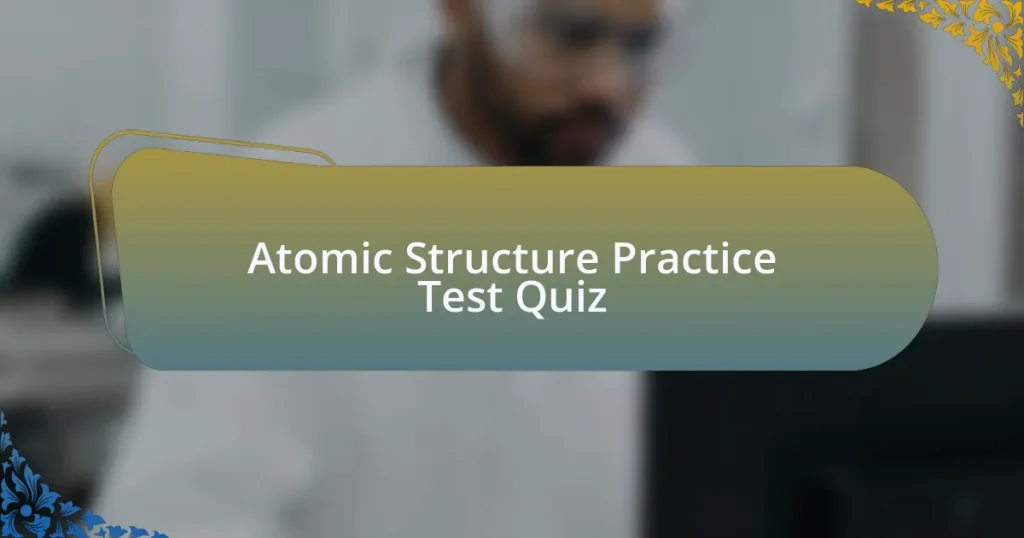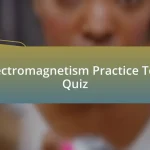Start of Atomic Structure Practice Test Quiz
1. Which statement concerning elements is true?
- Elements are composed entirely of neutrons and protons.
- All elements have the same number of electrons.
- Every element consists of only one type of atom.
- An atom is mostly empty space with a dense, positively charged nucleus.
2. Which two particles each have a mass approximately equal to one atomic mass unit?
- neutron and positron
- proton and neutron
- electron and photon
- proton and graviton
3. Which conclusion was a direct result of the gold foil experiment?
- The gold foil experiment showed atoms are all negatively charged.
- Electrons are located inside the nucleus.
- An atom is mostly empty space with a dense, positively charged nucleus.
- Atoms are all solid with no space inside.
4. Compared to a proton, an electron has
- a mass number of 1.
- a greater charge than a proton.
- a significantly lower mass than a proton.
- a neutral charge compared to a proton.
5. Every chlorine atom has
- 19 protons and 20 neutrons.
- 17 protons and 18 neutrons.
- 35 electrons and 35 protons.
- 18 protons and 17 neutrons.
6. What can be determined if only the atomic number of an atom is known?
- The number of protons in the atom.
- The atomic mass of the atom.
- The mass number of the atom.
- The number of neutrons in the atom.
7. Which of the following atoms has the greatest nuclear charge?
- 36
- 12
- 20
- 58
8. What is the total number of neutrons in the nucleus of a neutral atom that has 19 electrons and a mass number of 39?
- 19
- 39
- 18
- 20
9. The weighted average of the atomic masses of the naturally occurring isotopes of an element is the
- average atomic weight of the element.
- mass number of the element.
- atomic mass of the element.
- atomic number of the element.
10. What is the mass number of an atom that consists of 20 protons, 20 neutrons, and 18 electrons?
- 35
- 20
- 40
- 18
11. An atom that contains 8 protons, 8 electrons, and 9 neutrons has
- an atomic mass of 17
- a proton count of 9
- a mass number of 8
- a neutral charge
12. Compared to an atom of C-12, an atom of C-14 has a greater
- mass.
- electrons.
- neutrons.
- protons.
13. Atoms of different isotopes of the same element differ in their total number of
- mass numbers
- electrons
- neutrons
- protons
14. Which particle has two neutrons?
- Helium
- Neon
- Argon
- Oxygen
15. The table below shows the number of subatomic particles in atom X and in atom Z. Atom X and atom Z are isotopes of the element
- Carbon
- Helium
- Oxygen
- Nitrogen
16. The table below gives information about the nucleus of each of four atoms. How many different elements are represented by the nuclei in the table?
- 3
- 5
- 4
- 2
17. What is the structure of a krypton-85 atom?
- It has 0 protons, 85 neutrons, and 0 electrons.
- It has 36 protons, 49 neutrons, and 36 electrons.
- It has 36 protons, 36 neutrons, and 49 electrons.
- It has 85 protons, 0 neutrons, and 0 electrons.
18. Which correctly represents an atom of neon containing 11 neutrons?
- 10 protons, 12 neutrons, and 10 electrons.
- 12 protons, 11 neutrons, and 10 electrons.
- 10 protons, 11 neutrons, and 10 electrons.
- 11 protons, 11 neutrons, and 10 electrons.
19. An atom of carbon-14 contains
- 6 protons
- 12 electrons
- 10 protons
- 8 neutrons
20. What is the total number of neutrons in an atom of ?
- 18
- 25
- 15
- 20
21. Which pair must represent atoms of the same element?
- (75.76 u)(75.76)
- (34.97 u)(75.76)
- (34.97 u)(34.97)
- (34.97 u)(0.0)
22. Which two nuclides are isotopes of the same element?
- (12.01 u)(14.00 u)
- (34.97 u)(35.97 u)
- (34.97 u)(74.76 u)
- (56.93 u)(57.93 u)
23. Consider the species 72Zn, 75As, and 74Ge. These species have:
- different isotopes.
- the same number of protons.
- the same mass number.
- the same number of neutrons.
24. Which model does not explain the stability of an atom?
- Bohr’s Model
- Quantum Mechanical Model
- Rutherford’s Model
- Plum Pudding Model
25. Experimentation with cathode-ray led to the discovery of-
- protons.
- photons.
- electrons.
- neutrons.
26. The principal quantum number describes-
- size of the orbital.
- shape of the electron.
- spin of the nucleus.
- charge of the particle.
27. Which of the following quantities can only be a whole number?
- Atomic number
- Electronegativity
- Mass number
- Energy level
28. What are nucleons? What is the name given to those atoms which have the same number of nucleons in them?
- ISOTONES
- ISOBARS
- ISOBARS
- ISOMERS
29. How many unpaired electrons are there in a carbon atom in the ground state?
- 4
- 1
- 2
- 3
30. What is the minimum number of quantum numbers required to specify an orbital? Name them.
- Two quantum numbers: n and l.
- One quantum number: n only.
- Four quantum numbers: n, l, m, and s.
- Three quantum numbers: n, l, and m.
Congratulations! You’ve Completed the Atomic Structure Practice Test
Great job on finishing the Atomic Structure Practice Test! This quiz has provided an excellent opportunity to deepen your understanding of atomic structure, including the arrangement of protons, neutrons, and electrons. You’ve explored essential concepts such as isotopes, atomic mass, and energy levels. Each question was designed to challenge your knowledge and enhance your skills.
As you answered the questions, you likely discovered new insights about how atoms interact and form the foundation of all matter. Understanding these principles is crucial for further studies in physics and chemistry. Each concept you’ve encountered can serve as building blocks for more advanced topics, making your preparation more effective.
We encourage you to continue your learning journey by exploring the next section on this page. Here, you’ll find more in-depth information about atomic structure that will enrich your knowledge and strengthen your test preparation. Make the most of these resources to further excel in your physics studies!
Atomic Structure Practice Test
Understanding Atomic Structure in Physics
Atomic structure refers to the organization of protons, neutrons, and electrons within an atom. Protons and neutrons form the nucleus, while electrons orbit around this center. Understanding atomic structure is fundamental in physics as it lays the groundwork for concepts such as chemical reactions, bonding, and the behavior of elements. Knowledge of atomic structure is crucial for mastering topics like quantum mechanics, periodic trends, and the laws of thermodynamics.
Components of Atomic Structure
The primary components of atomic structure include protons, neutrons, and electrons. Protons carry a positive charge and determine the atomic number. Neutrons, which have no charge, contribute to the mass of the atom. Electrons, negatively charged, occupy various energy levels or orbitals. Each component plays a vital role in defining the chemical properties and behavior of an element. Mastery of these components is essential for answering test questions related to atomic theory and elemental behavior.
Atomic Models in Physics Education
Several atomic models illustrate atomic structure, including the Bohr model and the quantum mechanical model. The Bohr model positions electrons in fixed orbits around the nucleus, while the quantum mechanical model describes the probability of finding an electron in a cloud-like region. Understanding these models enhances the grasp of atomic structure and its implications in physics. Students benefit from learning these models for effective problem-solving in test environments.
Practice Questions for Atomic Structure
Practice questions on atomic structure often include identifying atomic number, mass number, and calculating the number of protons, neutrons, and electrons in various isotopes. Typical questions may involve determining the stability of isotopes or understanding electron configurations. Engaging with these questions helps reinforce comprehension of atomic principles, making it easier to tackle related concepts in physics tests.
Importance of Atomic Structure in Physics Tests
Atomic structure is a cornerstone of many physics tests. Questions may cover topics like nuclear reactions, isotopic notation, and electron transitions. Familiarity with atomic structure not only aids in answering direct questions but also enhances understanding of related subjects like energy levels and electromagnetic radiation. A solid grasp of atomic principles directly contributes to better performance on physics practice tests and examinations.
What is an Atomic Structure Practice Test?
An Atomic Structure Practice Test is a set of questions designed to evaluate a student’s understanding of atomic theory and structure. It typically includes problems related to the arrangement of electrons, protons, and neutrons within an atom. These tests help students prepare for exams by reinforcing key concepts in atomic physics, as outlined in educational standards such as the Next Generation Science Standards (NGSS).
How do you prepare for an Atomic Structure Practice Test?
To prepare for an Atomic Structure Practice Test, students should review their class notes and textbooks on atomic theory. Practicing with sample problems and previous tests is also beneficial. Utilizing online resources, such as educational platforms like Khan Academy, offers additional practice and explanatory materials. This mixed approach ensures a comprehensive understanding of atomic structure principles.
Where can you find Atomic Structure Practice Tests?
Atomic Structure Practice Tests can be found in various educational resources. Websites like Quizlet and educational platforms offer downloadable tests and quizzes. Additionally, many physics textbooks include end-of-chapter practice tests. These resources provide diverse question types, enhancing test preparation efficiency.
When should you take an Atomic Structure Practice Test?
You should take an Atomic Structure Practice Test after completing your study of atomic theory and structure, typically before an exam. Practicing in advance allows for identification of any knowledge gaps. Timing the test around one to two weeks prior to a significant exam is optimal for reinforcing learning.
Who benefits from an Atomic Structure Practice Test?
High school and college students studying physics, chemistry, or related fields benefit from an Atomic Structure Practice Test. Such tests aid in solidifying foundational knowledge about atoms, which is crucial for understanding more complex scientific concepts. Teachers also utilize these tests to assess student comprehension and readiness for further studies.















